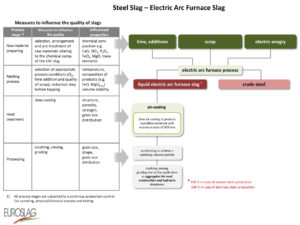Electric arc furnace slag
Electric arc furnace slag is produced during the manufacture of crude steel by the electric arc furnace (EAF) process. In this process steel scrap with additions of fluxes (e.g., lime[stone] and/or dolomite) are heated to a liquid state by means of an electric current. During the melting process the fluxes combine with non-metallic scrap components and steel incompatible elements to form the liquid slag. As the slag has a lower density than steel, it floats on top of the molten bath of steel. The liquid slag is tapped at temperatures around 1600 °C and allowed to slowly air-cool forming crystalline slag.
Depending on the intended steel quality (carbon steel or stainless/high
alloy steel), two different slag types can be generated:
- EAF C: Electric arc furnace slag from carbon steel production
- EAF S: Electric arc furnace slag from stainless steel production
For the carbon steel production non-alloyed steel scrap is used as input material. In contrast, for the stainless/high alloy steel production low- or high alloyed steel scrap is used and other metals (alloys) are optionally added along with the fluxes to give the crude steel the required chemical composition.
Electric arc furnace (EAF) slag is a strong, dense, none porous aggregate that is cubical in shape, has good resistance to polishing and has an excellent affinity to bitumen. This makes it an ideal aggregate for asphalt surface materials and road surface treatments as it produces materials that are resistant to deformation (rutting), safe and durable.

